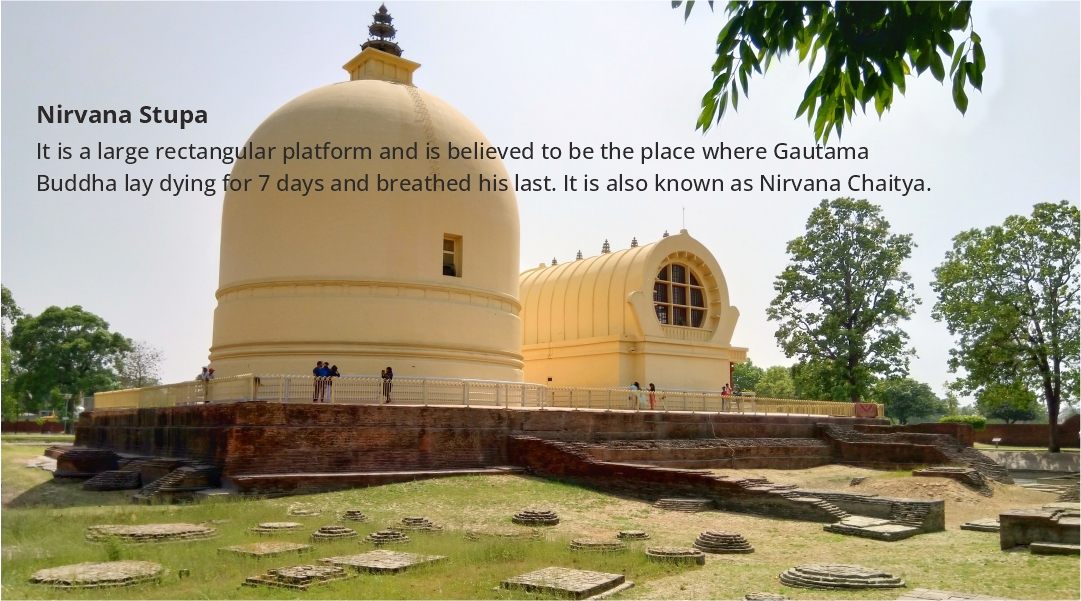Kushinagar, Uttar Pradesh
Been there recently?
This historic city is one of the four important holy destinations after Lumbini, Bodh Gaya and Sarnath for the followers of Gautama Buddha. Buddha made his last sermon and attained nirvana here in the year 487 BCE. The small town is deeply rooted in religion, divinity and more importantly, spirituality and the visitors can feel these at every step. Buddha suffering from illness selected this city as his final resting place thus immortalising Kushinagar then known as Kushawati and also as Kushinara. October to March is the best time to visit Kushinagar. The city is about 320 kilometres from Lucknow, the state capital. The nearest railway station is at Gorakhpur, about 50 kilometres away. Kushinagar has an International Airport.

Nearby Places to See
Mahaparinirvana Temple
The reclining Buddha also known as the dying Buddha statue in this temple recounts the days when Buddha lay dying after a meal. The statue was discovered by British Archaeologists in 1876 and is believed to be installed by King Ashoka nearly 225 years after Buddha’s death.
The reclining Buddha also known as the dying Buddha statue in this temple recounts the days when Buddha lay dying after a meal. The statue was discovered by British Archaeologists in 1876 and is believed to be installed by King Ashoka nearly 225 years after Buddha’s death.


Hiranyavati Ghat
Located close to Rambhar Stupa, it is the place where Buddha’s ashes were immersed.
Located close to Rambhar Stupa, it is the place where Buddha’s ashes were immersed.
Kushinagar Museum
The museum takes the visitors through a historic tour of Kushinagar. Also on display are idols, coins, paintings, and many artefacts.
The museum takes the visitors through a historic tour of Kushinagar. Also on display are idols, coins, paintings, and many artefacts.
Ramabhar Stupa
In Buddhist scripts, it is mentioned as Mukuta-bandhana chaitya. When excavated in 1910, it was covered with 40 feet high bricks. After the cremation of Buddha’s body, one-eight of his remains was placed in this temple by the Mallas who were the rulers.
In Buddhist scripts, it is mentioned as Mukuta-bandhana chaitya. When excavated in 1910, it was covered with 40 feet high bricks. After the cremation of Buddha’s body, one-eight of his remains was placed in this temple by the Mallas who were the rulers.

Sun Temple
Located at a place called Turkpatti, about 20 kilometres from Kushinagar, it is an ancient temple with an attractive statue of the Sun God. The fallen temple was excavated nearly 150 years ago, and the statue found was installed after a new temple was built.
Located at a place called Turkpatti, about 20 kilometres from Kushinagar, it is an ancient temple with an attractive statue of the Sun God. The fallen temple was excavated nearly 150 years ago, and the statue found was installed after a new temple was built.
Other Temples
Many Buddhist countries have built temples in Kushinagar. The most attractive of these is the Burmese temple, which is in circular shape and golden colour. Other temples are the Thai temple, Vietnamese temple, Korean temple, Japanese Temple, Tibetan temple, and Sri Lankan temple.
Many Buddhist countries have built temples in Kushinagar. The most attractive of these is the Burmese temple, which is in circular shape and golden colour. Other temples are the Thai temple, Vietnamese temple, Korean temple, Japanese Temple, Tibetan temple, and Sri Lankan temple.

-
Destination



